by Deep Green Resistance News Service | Jan 26, 2016 | Lobbying
Native advocates for the creation of Bears Ears National Monument in southeastern Utah will begin meetings later this month with the administration of President Barack Obama after parting company with Congressional delegates who they say repeatedly disrespected their efforts.
The proposed 1.9-million-acre monument lies north of the Navajo Nation and the San Juan River, east of the Colorado River, and west of the Ute Mountain Ute Reservation. It encompasses all of Natural Bridges National Monument and the Manti La Sal National Forest, and parts of Glen Canyon National Recreation Area. It is adjacent to, and immediately east of, Canyonlands National Park.
RELATED:Tribes Ask President Obama to Designate Bears Ears as National Monument
The drumbeat to protect the landscape began six years ago with local Navajo and non-Native activists and quickly garnered the support of local rock climbing groups who liked the idea of protecting some of their favorite recreation areas.
RELATED: Bears Ears Sacred Site Unites 24 Tribes With Rock Climbers, Conservationists
The past year saw the formation of the Bears Ears Coalition, with representatives from the Navajo, Hopi, Ute Mountain Ute, Uinta & Ouray Ute and Zuni nations, which furthered those initial efforts to draw wide support from southwestern pueblos and tribes as well as the National Congress of American Indians.
“This is about healing. We’re not only trying to heal the land and its ecology, but people who relate to these lands,” said Eric Descheenie, advisor to Navajo Nation President Russell Begaye, and co-chair of the Bears Ears Coalition. “This is an indigenous vision that has inspired cross-disciplinary professionals to join on. We have non-Indians, we have all kinds of groups in the public and private sector. We want to elevate this discussion in a way that we can all celebrate.”
Members of the Coalition unveiled a formal monument proposal in Washington last fall that advances an unprecedented vision for collaborative management between tribes and the federal government.
RELATED: Bears Ears 1.9 Million–Acre Monument Would Be Unique Tribal-Federal Collaboration
Even in October, Coalition members viewed their proposal as a more protective alternative to the Public Lands Initiative (PLI) spearheaded by representatives Rob Bishop (R-Utah) and Jason Chaffetz (R-Utah). In an appendix, they chronicled six years of tribal members’ thwarted attempts to work within the PLI process in both Utah and Washington D.C.—efforts that were met with polite indifference at best, and racism at worst. Still, the coalition made one more effort to work within the PLI.
“I was excited with the thought that we might be able to work within the legislative process,” recalls Regina Lopez-Whiteskunk, a member of both the Bears Ears Coalition and the Ute Mountain Ute Tribal Council. But she said she was disappointed with the one-sided nature of the efforts.
“I had to take a step back and really think about how the federal government interacts with tribes,” she said. “When we pursue grants for the development of programs, we’re given deadlines and requirements, and we take them very seriously.” But Lopez-Whiteskunk said the PLI leaders consistently blew deadlines, never produced promised drafts of their own proposal, and failed to show up for scheduled meetings.
“When I started to see things kind of falling by the wayside, I began to realize, maybe the only way we’re going to be able to do this is through the executive order process,” she said.
Lopez-Whiteskunk said she owes it to her people, and her ancestors who once inhabited the Bears Ears lands, to forego the legislative path. Instead, the Coalition is pursuing negotiations with the Obama administration to secure a presidential proclamation under the Antiquities Act.
“We have come to the conclusion that we have no choice but to discontinue these discussions,” reads part of the Coalition’s letter to Chaffetz and Bishop, dated December 31. “Our strenuous efforts to participate in the PLI have been consistently stonewalled. We have never been taken seriously.”
Chaffetz issued a statement in response to the letter, calling it “unexpected and confusing.” He chalked up his staff’s failure to show up at a scheduled December 30 meeting with the Coalition as a “scheduling conflict” and vowed to move forward with the PLI.
Bishop also responded, saying the coalition did not represent all interests.
“The Native Americans who live in Utah and who would be most impacted by a national monument do NOT support the proposal of this group,” he wrote in a statement e-mailed by his communications director, Lee Lonsberry. “It is clear this self-appointed coalition has an agenda that we need to reconcile with the wishes of those who actually call Utah home.”
Lonsberry added that the Navajo Nation’s Aneth Chapter, which lies closest to the proposed monument and within Utah, is against the proposal. But the Navajo Nation Council passed a resolution in support of the Bears Ears proposal last fall, with unanimous support by delegates representing the Nation’s 110 chapters. Council Delegate Davis Filfred, who represents five chapters in Utah including Aneth, says the statements are unfounded and misleading. He pointed out that six of seven Utah chapters support the Bears Ears proposal.
“The Navajo Nation is supporting Bears Ears,” he said, “not only from the council, but from the executive side as well. I do support this.”
For his part, Descheenie took offense at Bishop’s characterization of the Bears Ears Coalition as what he called a “self-appointed coalition.”
“We don’t feel they respect the sovereignty of tribes,” he said.
Descheenie added that he’s proud of the coalition’s proposal and looks forward to earnest negotiations with the Obama administration.
“My hope is that when we take our ideas and match them up against the Obama administration’s expertise, our proposal will become that much better, and that it truly will become a model for collaborative management worldwide,” he said. “We’re hoping that people come to the table with positive hearts and fruitful minds, with an interest in figuring out how this can work.”
Lopez-Whiteskunk said she’s excited for an opportunity to showcase a great idea out of Indian country.
“I’ve been elected by my people, but now I have an opportunity to be a leader for many people,” she said. “This is about healing that doesn’t see colors or boundaries. It’s not just going to be a people’s movement of the Native people. It will be a peoples’ movement for all people.”
Anne Minard is a journalist and a law student at the University of New Mexico. She is working for the Bears Ears Coalition as a legal research assistant.
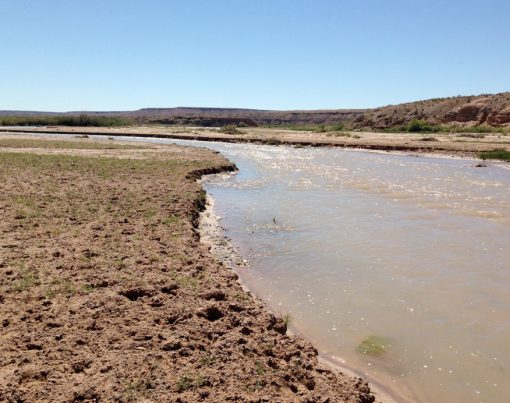
by Deep Green Resistance News Service | Jan 11, 2016 | Biodiversity & Habitat Destruction
By Katie Fite / WildLands Defense
This article first appeared on Counterpunch
Featured Image: Virgin River with banks trampled like a feedlot by Cliven Bundy cattle. May 2015.
In Oregon, an armed occupation of Malheur Wildlife Refuge headquarters is being led by self-proclaimed “patriots” from Nevada. They are defending a public lands ranching family’s “right” to set fires and break the law.
In Nevada, Cliven Bundy owes more than a million dollars in grazing fees. An armed confrontation broke out when BLM began to impound his trespass livestock. The government backed down. For almost two years, no action has been taken while the Bundy camp becomes ever more brazen. This past summer, when Cliven Bundy went to the Nevada legislature to support a bill to turn over federal authority of public land to the state, he was treated to a barbecue by Nevada Congressman Mark Amodei.
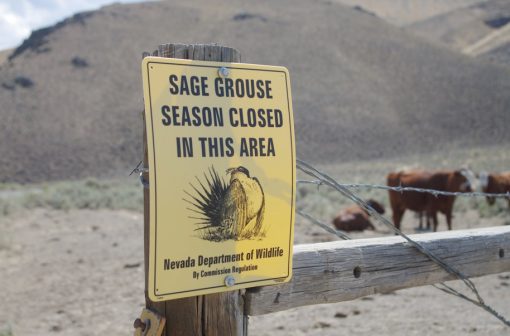
Cliven Bundy is not the only Nevada Rancher being given proprietary treatment by Nevada federal land managers. Settlement deals and BLM coddling reward hostile ranchers at the expense of the public’s land.
Argenta Allotment Settlement
There has been prolonged, severe drought in Nevada. In 2014, defiant public lands ranchers resisted Battle Mountain BLM drought closures and cattle cuts in the Argenta allotment. They were emboldened by the Bundy incident. The ranchers set up a “Grass Camp,” aided by instigator Grant Gerber, across from the BLM office. They have waged an intimidation campaign against agency staff. They whined incessantly to cattle friendly Nevada politicians Amodei and Senator Heller. The Elko paper did not really report, but instead was a worshipful cheerleader against the BLM. The ranchers denied there even was a drought. At the very same time, they received lavish federal drought disaster relief payments.
The cattle damage became so severe that by late summer the local BLM finally closed the sensitive sage-grouse habitats in mountain pastures of the Shoshone Range to grazing. The ranchers and states rights politician John Carpenter appealed the protective closure. In spring 2015, an Interior Department Office of Hearings and Appeals administrative law judge finished review of a mountain of documents, and ruled in favor of the closure.
But within weeks, BLM folded. All of Argenta was again flung open to grazing. Leadership under Nevada BLM Director John Ruhs had forced a settlement deal indulging the ranchers’ every whim. Ruhs, bonded at the hip with the Cattlemen, had been “Acting” Director, and then officially became Nevada Director.
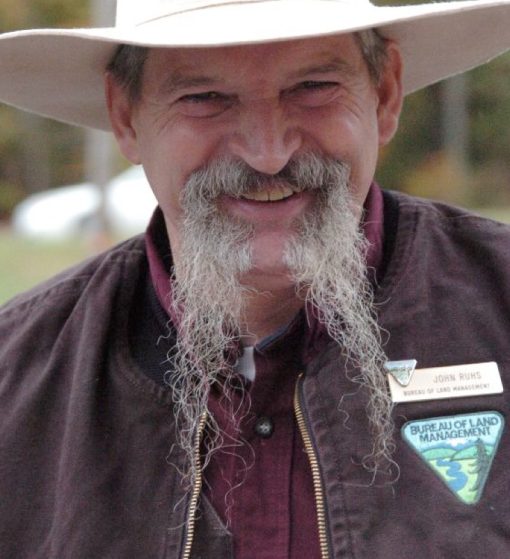
Nevada BLM Director John Ruhs
The deal was greased through by the “National Riparian Team,” composed of livestock industry sycophants from within BLM and the Forest Service, and outside cattle consultants.
The Team, while claiming to be a neutral party, immediately took the ranchers’ side – with Team members railing against perceived interference by the local BLM staff that had sought to control cattle damage to the public lands. So it’s no surprise the settlement flung open sensitive closed sage-grouse habitats to full bore grazing. Herds of several hundred cows were allowed to trample and devour “forage” across the drought-stricken public land in 2015.
The settlement put the Team in charge of a Coordinated Monitoring Group “(CMG”) dominated by ranchers and a token enviro group to take control of monitoring, to direct management actions, and run interference with the local BLM so the Argenta ranchers would not be accountable for grazing damage or trespass.
The cabal bars the public and press from observing their monitoring of grazing damage, and from their closed door discussions that dictate management. The group tells BLM what to do to keep the ranchers happy.
The result has been grazing chaos, and wanton damage of lands and waters. Wildlands Defense (WLD) and colleagues visited Argenta to observe and document conditions. Cattle were scattered all over the allotment, and riparian areas ravaged. When we asked BLM where cows were supposed to be present, the local BLM managers did not even know. All was in the hands of the Team and CMG.
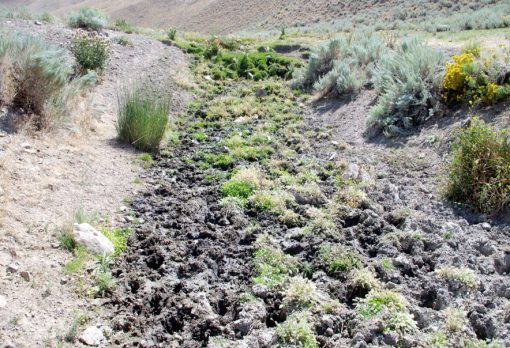
Cattle trampling dries out and destroys sage-grouse brood habitats.
Scads of new cattle projects are also laid out in the settlement. A July Team memo plans new barbed wire fencing and water projects incrementally sprawled across Argenta. The Team embraces injurious grazing practices – severe cattle trampling soil disturbance and high use of native grasses. Why the projects? So ranchers don’t have to work to control their cows. This frontloads Argenta with band-aid fences around prominent degraded areas (and long term monitoring sites) close to roads, prior to any thorough Land Health assessment. There never has been any grazing study since the 1976 passage of FLPMA. The ranchers can then claim conditions within the little fenced areas are “improving,” and insulate against cattle cuts in an assessment.
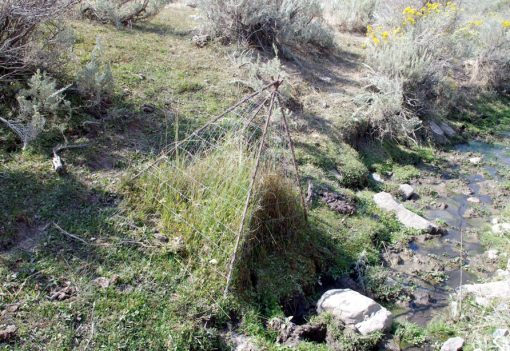
Monitoring cage illustrating how severe cattle use is. Our site visits found such cages destroyed in some areas since the CMG group took over.
This fall, BLM obediently issued a Decision giving the ranchers six new permanent fences, plus “temporary” water troughs and a pipeline. WLD and Wild Horse Education appealed the first battery of projects, which are terrible for wildlife. Sage-grouse and other wildlife are killed by flying into or becoming entangled with wire. The projects also shift intensive impacts onto other areas. We also challenged the Ruhs Settlement – which has altered grazing, established the exclusive closed meetings, and directed the projects. BLM claims we can’t appeal the Settlement.
Now over the holidays, BLM proposed more projects. The ranchers, through the cover of the Team and CMG, are essentially now running the public lands.
North Buffalo Settlement
Days after BLM caved in Argenta, one of the very same permittees, Filippini Ranch, rewarded BLM appeasement efforts by unleashing their cattle on the nearby North Buffalo allotment. North Buffalo, like Argenta, was closed for drought protection. It is home to a very small struggling population of sage-grouse, whose habitat is also being consumed by foreign gold mines.
BLM could not help but notice the cows turned out illegally, since the ranch owner told about the trespass to the Elko newspaper, flaunting his power. Leadership under Ruhs promptly rewarded this trespass with another Settlement deal. Just as in Argenta, a North Buffalo Settlement flung open the closed lands. BLM charged Filippini around $100 for willful trespass – a small price for being allowed access to tens of thousands of dollars worth of public lands “forage” for which the permittees pay a pittance.
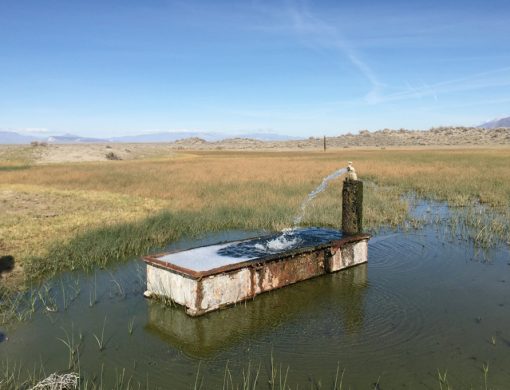
Uncapped abandoned test well site in now Wilderness lands where rancher claimed water rights.
DeLong and Humboldt County Settlement
There is yet another Settlement deal gift to a powerful rancher, this time in Winnemucca BLM lands. The powerful Delong ranching operation and Humboldt County had sued BLM over a raft of access issues primarily involving cattle water projects, many in Wilderness areas with no access roads. The projects had not been recognized by BLM when compiling project lists following the passage of the Black Rock Wilderness legislation in 2000. The lawsuit involved arcane regulations originating in the 1800s and early 1900s. BLM issued a scoping letter this fall proposing to maintain, reconstruct and access 15 cattle projects, access private inholdings, and maintain irrigation ditches – mainly in the North Jackson, South Jackson and Black Rock Wilderness in the South Jackson allotment.
BLM did not tell the public in its confusing letter that the proposal was based on yet another recent Settlement deal. We only learned of this when querying the BLM staff.
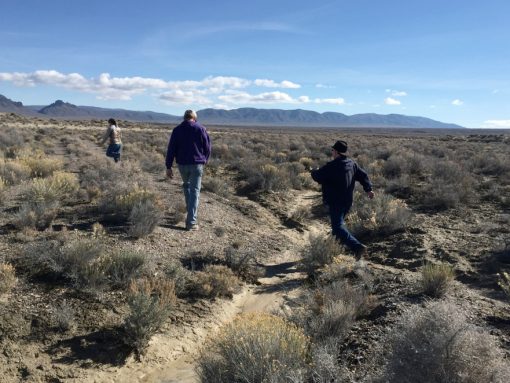
BLM field trip in area where rancher is being allowed access for cattle water project.
Hold Your Wild Horses
BLM leadership has knowingly looked away from a series of purposeful and blatant violations of the Code of Federal Regulations by a rancher (Borba) in the Fish Creek wild horse Herd Management Area in Battle Mountain country.
The rancher was found to be in “willful trespass,” grazing his livestock outside the boundaries of his legally authorized use for eight months. Under pressure from politicians Heller and Amodei, the BLM reduced the trespass and lowered fees.
The rancher and Eureka County also became upset over a local BLM decision to manage wild horses to incrementally reduce the population. The BLM removed over 200 wild horses, and then planned to use the PZP fertility control drug, and release horses given fertility control back to the HMA. In a stand-off reminiscent of an old western movie, the county and rancher showed up onsite and demanded the BLM not release the horses.
The BLM caved, and the horses were hauled away. After a lengthy legal battle the horses were returned to the range months later.
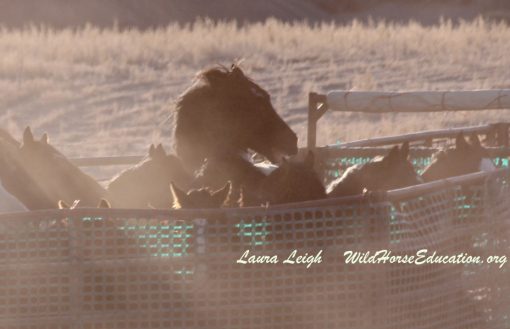
The disgruntled rancher began a social media campaign to rile the public against “government abuse.” Claims were made that he was never in trespass. He videotaped himself repeatedly breaking the law, and put it on social media. The penalties for the acts committed clearly state that the permittee will face fines, possible jail time and “shall” lose the right to graze on public lands.
Ruhs met with the rancher, County and local BLM Manager Furtado at Fish Creek, and sided with cattleman over his own staff. The BLM state office has now put the brakes on the fertility control program for the Fish Creek wild horses. This winter, the permittee is grazing livestock as if nothing happened.
Is It Continued Bungling, Political Interference or Tacit Support?
Badly bungling the Bundy situation and failing to act for almost two years now, the BLM opened the floodgates of rancher defiance and Sagebrush Rebel hell. The Ruhs Settlement deals reward powerful public lands ranchers who hate the agency and the very concept of public good and public lands. Allowing violations of federal law to go unaddressed has created an environment where any concept of law appears meaningless. The Settlements in Argenta, North Buffalo, Jackson Mountain/DeLong, coupled with BLM leadership ignoring blatant Fish Creek rancher law-breaking, embolden the very parties who want to see the public lands become unmanageable by the federal government.
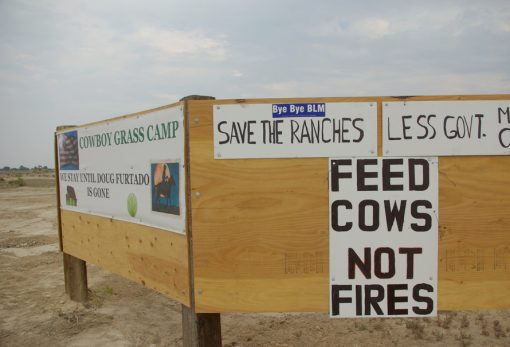
Safety of BLM employees on the ground has been jeopardized. The ranchers want removed anyone who might attempt to protect the environment. Their intimidation campaign is demanding Battle Mountain District Manager Doug Furtado be fired. The local office has been rendered powerless.
Appointment of Ruhs as Nevada Director, sweetheart settlement deals and toleration of overt law-breaking all have taken place under national BLM Director Neil Kornze, a native of Elko, Nevada and son of a mining engineer.
Is this ineptitude on the part of BLM leadership, political interference, or something else? Kornze increasingly appears to be either the most bungling BLM Director ever – or a fellow traveler with the Nevada public Land Grab crowd. While we continue to see PR photos of the BLM Director on outdoor excursions, important areas of the American West are being handed over to the welfare ranchers through a policy of capitulation and appeasement – resulting in a de facto loss of federal control and stealth Land Grab.
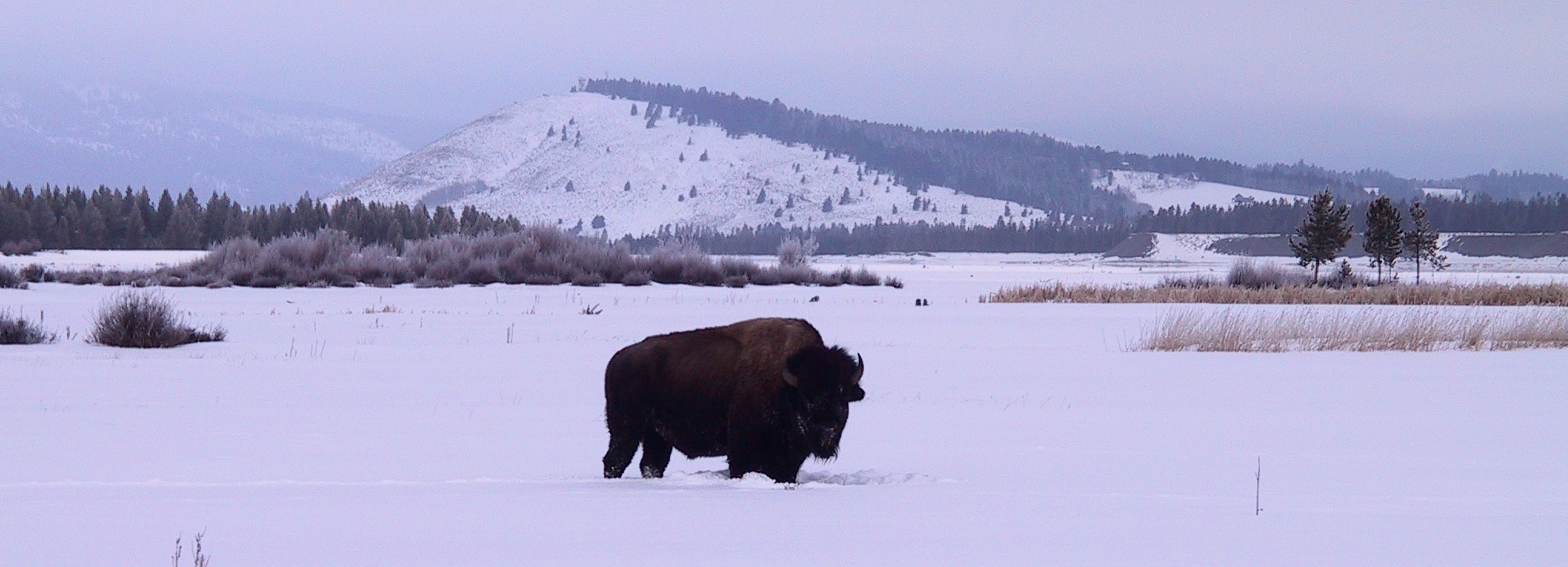
by DGR Colorado Plateau | Dec 24, 2015 | Listening to the Land, Lobbying
By Stephany Seay / Buffalo Field Campaign
Featured image: Hundreds of wild buffalo will no longer be harassed or otherwise harmed on the Horse Butte peninsula, seen in the distance here. Photo by Buffalo Field Campaign.
Yesterday, Montana Governor Steve Bullock issued his final decision on year-round habitat for wild bison in Montana, and Buffalo Field Campaign is very pleased to announce that after more than eighteen years of fighting for wild buffalo to freely roam Horse Butte, we have finally achieved this significant victory! As many of you know, Horse Butte is part of what we have been pressing for since the beginning of our campaign, and we are inclined to celebrate this achievement as the victory that it is; indeed, it may be the biggest victory we have had! It took nearly two decades of hard work in the field, in the courts, and in the policy arena to accomplish this, and it demonstrates how perseverance pays off, and how we must never give up.
This victory is a result of endless pressure, being endlessly applied by BFC, by you our dedicated supporters, by the incredible and active residents of Horse Butte, and by the buffalo themselves who consistently demonstrate resistance, persistence, and endurance. Another boon granted the buffalo is that bull bison — but only bulls — will be given year-round habitat in the Gardiner Basin. Please take a little time to celebrate this victory, as it has been hard-earned by each of you. Thank you to everyone who has been with us for the buffalo, making our work possible.
As we bask in this triumph, we cannot let down our guard. We must strengthen our resolve to continue fighting for wild buffalo and their right to roam the lands that are their birthright. We have many difficult battles yet to win. A closer look at Governor Bullock’s decision shows us that the buffalo are still in grave danger from livestock industry interests and the government agencies that serve them.
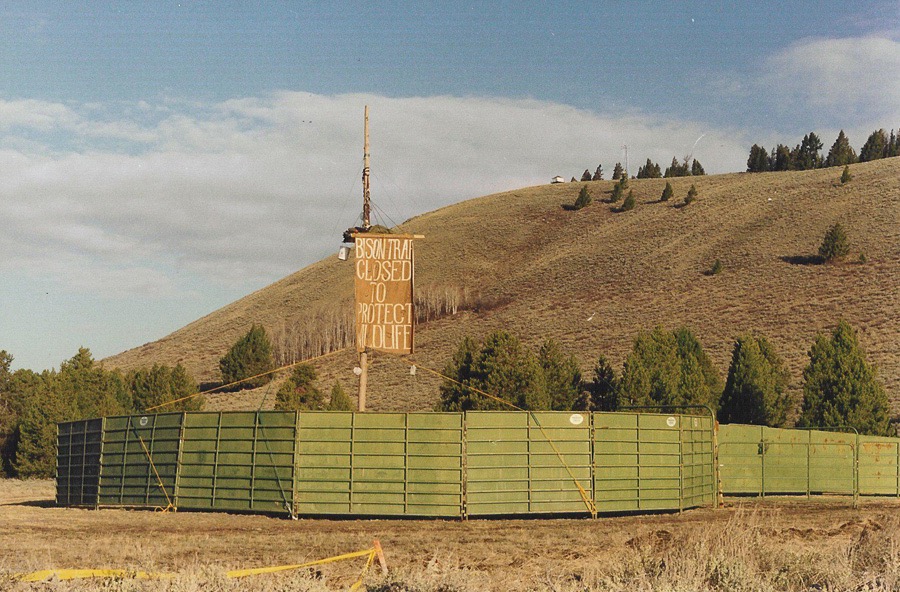
In 2004, the courageous and passionate Akiva Silver occupied the Horse Butte bison trap, saving many buffalo from being captured and shipped to slaughter. In 2008, the trap was again occupied by another brave individual, and the Montana Department of Livestock have not set it up since, nor will they ever again. Buffalo Field Campaign photo by Chris Rota.
Even the decision to grant buffalo year-round habitat on Horse Butte has its devilish details, mainly in the form of a population cap: during fall and winter approximately 450 buffalo will be allowed to live there; during the spring that number rises to 600, which is terrific timing since that’s when the large herds come to Horse Butte for calving season; but by July the government will allow only 250 buffalo to remain. From reviewing the Governor’s decision, it appears that, should there be more than 250 buffalo on Horse Butte by summer, hazing would not begin until then, which is about six weeks later than hazing has been taking place in recent years. While our ultimate goal is to put an end to all hazing, this means that wild buffalo will finally have the opportunity to make their own choices about when or whether to migrate into Yellowstone for the summer months. It will be an awesome gift to learn what they will do directly from the buffalo.
The deeper you look into the Governor’s decision, the more questions it raises. Hazing, hunting, and capture-for-slaughter remain tools that the livestock-backed government agencies will employ, with goals of keeping this highly vulnerable — and indeed, endangered — population at artifically low numbers. Additionally, wild buffalo will not be granted any “tolerance” along the south side of the Madison River, which is favored habitat, mostly public lands, that the matriarch-led family groups very much enjoy and require during the months surrounding calving season. Also, in the Gardiner Basin, matriarch-led family groups will not have full access like their adult male counterparts, but will be given tolerance only during “hunting” season, and will be hazed into Yellowstone by mid-spring.
Again, we have a long way to go for the buffalo. We need you to join with us in strengthening your resolve and renewing your commitment to do whatever it takes to defend our beloved wild buffalo until they roam free all across the lands that have been their home since buffalo time began.
Support Buffalo Field Campaign here.
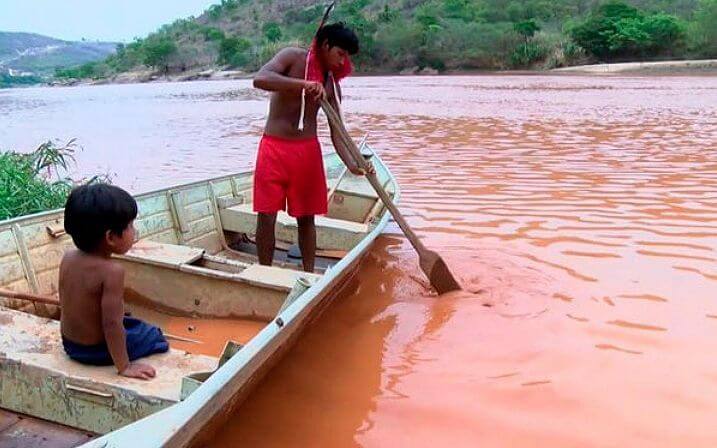
by DGR Colorado Plateau | Dec 3, 2015 | Biodiversity & Habitat Destruction, Indigenous Autonomy
by Marcela Belchior / Adital via Intercontinental Cry
What would initially appear to be the end of the line for the culture and survival of the Krenak indigenous people, impacted by the pollution of the Rio Doce, from the Mariana tragedy, in southeastern Brazil [state of Minas Gerais], could rekindle a 25 year struggle. After being left unable to live without the water of the river, the Krenak population is mobilized around a possible solution for the continuity of the community: to expand the demarcated area of the indigenous territory in the region and to migrate to a new location.
In an interview with Adital, Eduardo Cerqueira, member of the Indigenist Missionary Council (CIMI), Eastern Regional office, which comprises the states of Minas Gerais, Espírito Santo and the extreme south of Bahia, affirms that, as a way to resist the tragedy, the Krenak community [is calling] on the federal government to expand the demarcated area into 12,000 adjacent hectares, embracing the region where the State Park of Sete Salões, one of the Units of Conservation of nature belonging to the Government of Minas Gerais, is currently located.
“We find the strategy interesting, given that the existing area no longer provides conditions for survival. Something must be done”, attests Cerqueira. At present, the demarcated area of Krenak territory covers 4700 hectares. In this zone, extending more than three kilometers along the Doce River have been impacted and rendered unfit for drinking, fishing, bathing and irrigating vegetation in the vicinity, in the municipality of Resplendor, where 126 Krenak families live.
The State Park Parque de Sete Salões was created in 1998, and includes the municipalities of Conselheiro Pena, Itueta and Santa Rita do Itueto, corresponding to one of the largest remnants of Atlantic Forest in eastern Minas Gerais, with mountains, forests and waterfalls. Besides this, the area demanded has potential for indigenous community tourism, receiving visitors and marketing crafts, without damage to the environment.
The territory of the Krenak population, in Minas Gerais, was demarcated in the 1990s, but the entire length of the park was excluded, which today could once again be placed on the agenda. In the early 2000s, the Indigenous people filed a claim with the National Indian Foundation (Funai) and the federal government conducted a technical study on the matter, which to date has not been published. In the opinion of the Krenak, now, the situation is more than appropriate to fulfill the historical demand of the population.
“Various indigenous leaders are concerned about the territorial question. Now, it is a matter of necessity for this concern to be the focus of discussion. (…) This part of the region was not affected by the tailings [pollution],” defends the indigenous advocate. According to the CIMI counselor, since the socioenvironmental tragedy, the indigenous peoples affected have been assisted with emergency support, by means of tank trucks supplying water, transfer of basic food baskets and financial support for the families, which would ensure the community’s survival only in the short term.
“This tragedy was intensified by a period of severe drought. For over a year there has been no rain in the region. Because of this, the tributaries of the Rio Doce are dry. (…) The terrain is not favorable to agriculture. Livestock would be the most common form of indigenous survival, but it is not possible, without water,” explains Cerqueira.
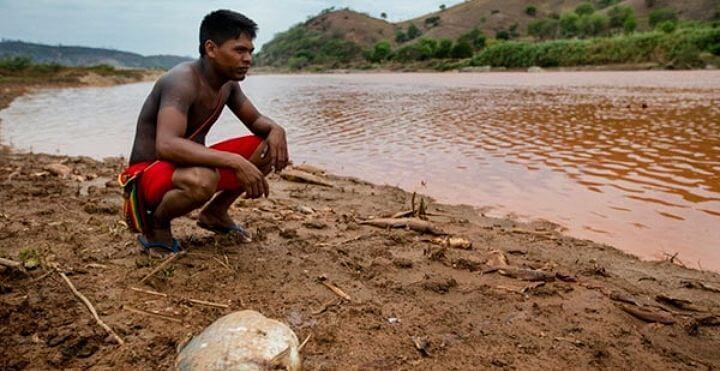
Geovani Krenak laments the death of the Rio Doce: “we are one, people and nature, only one,” he says. Photo: Reproduction.
UNDERSTANDING THE CASE
A torrent of mud composed of mining tailings (residual waste, impurities and [chemical] material used for flushing out minerals) has been flooding the 800 kilometer length of the Rio Doce since November 5, after the rupture of the Fundão dam, of the Samarco mining company. This is controlled by Vale, responsible for innumerable and grave socioenvironmental damages in Brazil, and the multinational Anglo-Australian BHP Billiton, two of the largest mining companies in the world.
In addition to burying an entire district, impacting several others and polluting the Rio Doce, extending through the states of Minas Gerais, Espírito Santo and Bahia, the mud reached the sea over the weekend, even further amplifying the environmental damage, which could take more than two decades before signs of recovery even begin to present. In addition to the destruction of fauna and flora, seven deaths and 17 disappearances have so far been recorded.
KRENAK PEOPLE CLOSE ROAD IN PROTEST
Early last week, representatives of the Krenak indigenous people, whose tribe is situated on the banks of the Rio Doce, interrupted, in protest, the Vitória-Minas Railroad. Without water for more than a week, they said they would leave only when those responsible for the tragedy talk with them. “They destroyed our lives, they razed our culture and ignore us. This we do not accept,” asserted Aiah Krenak to the press.
Considered sacred, in a culture whose cosmological worldview is based on the interconnection between all beings – humans, plants, animals, etc., the river that flows through the tribe was utilized by 350 Indians, for consumption, bathing and cleansing. “With the people, this is not separate from us, the river, trees, the creatures. We are one, people and nature, only one”, says Geovani Krenak.
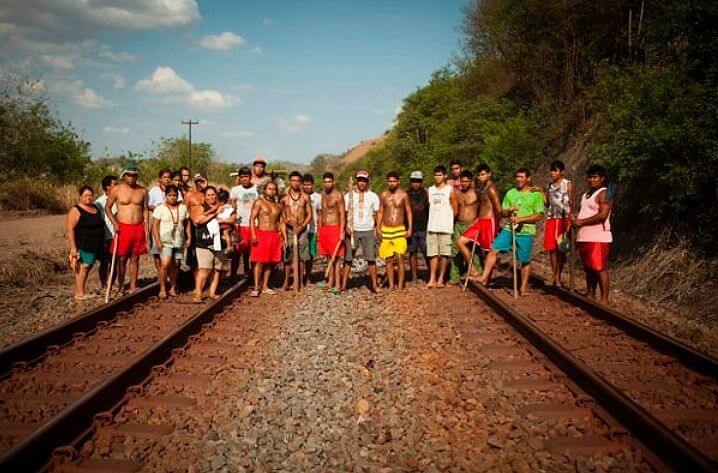
Krenak people protest on the Vitória-Minas Railroad. Photo: Reproduction.
Seated along the tracks, under a 41C. degree sun, Indians chanted music in gratitude to the river, in the Krenak language. “The river is beautiful. Thank you, God, for the river that feeds and bathes us. “The river is beautiful. Thank you, God, for our river, the river of all of us,” the words of shaman Ernani Krenak, 105 years of age, translated for the press.
His sister, Dekanira Krenak, 65 years old, is attentive to the impact of the death of the river affecting not only the indigenous peoples, being a source of resources for many communities. “It is not ‘us alone’, the whites who live on the riverbank are also in great need of this water, they coexist with this water, many fishermen [feed their] family with the fishes,” she points out.
Camped on site in tarpaulin shacks and sleeping mats in the open air, the Indians, now, must also face an unbearable swarm of insects. “It was never like this,” says Geovani Krenak. “These mosquitoes came with the polluted water, with fish that once fed us and that are now descending the river, dead, he reports.
Article originally published in Portuguese at
Adital. Translated to English for Intercontinental Cry by M.A. Kidd. Republished with permission of Intercontinental Cry.
by DGR Colorado Plateau | Oct 15, 2015 | Listening to the Land, Lobbying
By Center for Biological Diversity
After pressure from the Center for Biological Diversity and allies, the U.S. Fish and Wildlife Service announced Wednesday it will release about 10 Mexican gray wolves into the wilds of southwestern New Mexico–a move scientists say is crucial to reduce dangerous inbreeding of the rare creatures.
Just days earlier, the Center and allies sent a letter to Interior Secretary Sally Jewell, signed by 43 groups and scientists, asking her to release at least five packs of endangered Mexican gray wolves into New Mexico’s 3.3-million-acre Gila National Forest.
Back in 1998, after a Center lawsuit, the Service began reintroducing Mexican gray wolves from captive-breeding facilities into their historic U.S. Southwest range, where they had been obliterated by federal poisoning and trapping. But the Service only released wolves into a small part of Arizona’s Apache National Forest, which quickly filled with wolf families.
“Releasing Mexican wolves to the wild is the only way to save these animals from extinction,” the Center’s Michael Robinson told the Santa Fe New Mexican. “It’s vital now that enough wolves get released to diversify their gene pool and ensure they don’t waste away from inbreeding.”
Read more in the Center for Biological Diversity press release and the Santa Fe New Mexican.














